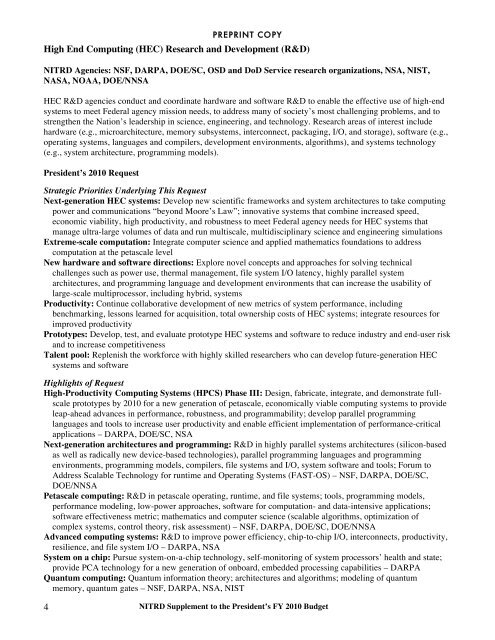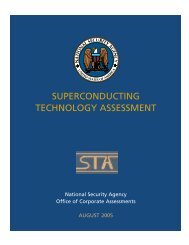PREPRINT COPYEPA: Applications in computational toxicology (toxicity modeling and toxicology database development), airquality (enhance code quality while maintaining modularity, portability)HEC infrastructureNSF: Develop numerical algorithms and innovative software implementations that push the boundaries ofcyberinfrastructure, computational science and engineering, and computing on the TeraGridNIH: Grid computing infrastructure and tools for R&D (e.g., BIRN, CaBIG, BISTI, CVRG)DOE/SC: Continue emphasis on unified approach to software, languages, and tools support to reduce barriers toeffective use of complex HEC resources by application developers and usersOSD (HPCMP): Operate, sustain supercomputing centers and support services for DoD RDT&E programsNIST: Development and analysis of fundamental mathematical algorithms and software; parallel and distributedalgorithms; interoperable MPI; high-end visualization toolsNASA: Increase commonality and enhance or adopt operational best practices across computing centersNOAA: Explore ways to coordinate Federal HEC resources “on demand” (surge computing) for critical eventsand continue to explore proof of concept partnerships for hurricane, weather, and climate-change modelingDOE/NNSA: Develop ASC common operating environment for deployment across its national lab platformsEPA: Continue building data and information exchange components, including work with NASA and NOAA onreal-time movement of large data sets through Remote Information Sensing GatewayPlanning and Coordination Supporting RequestAccess to leadership-class computing: Coordination to make highest-capability HEC resources available to thebroad research community – NSF, DOE/SC, NIST, NOAA, DOE/NNSASystem reviews, benchmarking: Collaborations – NSF, DOE/SC, NSA, NASA, NOAA, DOE/NNSAAcquisition procedures and analysis: Information sharing, streamlining of processes, and collaborative analysisof total cost of ownership – NSF, DOE/SC, OSD, NASA, NOAA, DOE/NNSA, EPAMultiscale modeling in biomedical, biological, and behavioral systems: Interagency collaboration to advancemodeling of complex living systems (e.g., Interagency Modeling and Analysis Group (IMAG) multiscalemodeling initiative, MIDAS Project) – NSF, NIH, OSDInfrastructure for climate and weather modeling: Development of interoperable interfaces, software tools, anddata standards – NSF (NCAR), DOE/SC, OSD, NASA, NOAA, EPASurge Computing: Discussing how to implement this capability – NOAA, NSF, DOE/SC, OSDComputational toxicology: Integration of HEC technologies with molecular biology to improve methods for riskassessment of chemicals – NIH, DOE/SC, OSD, EPA, FDAAdditional 2009 and 2010 Activities by AgencyNSF: Support Data-intensive Computing program projects that increase ability to build, use systems andapplications; expand TeraGrid to include new systems; develop cyberinfrastructure software (e.g., fordebugging, fault tolerance, performance tuning, middleware, data handling); operational support for TeraGridNIH: International networks for biomedical data, software sharing; NIH Roadmap National Centers forBiomedical Computing (NCBCs); Cancer Imaging and Computational Centers; P41 computational centers;NLM servers; bioinformatics centers; proteomics, protein structure initiatives; systems biology centersDOE/SC: Manage LCF facilities at ORNL and ANL; support computation-intensive and data-intensiveapplications; new generation of petascale tools; optimization and risk analysis in complex systemsOSD (HPCMP): HEC services for R&D and test communities (e.g., platforms, computational science softwaresupport); computational science institutes for DoD priorities (air armament, health force protection, weatherprediction, ground sensors, space situational awareness, rotorcraft, networks, microwaves, munitions)NIST: Virtual measurement systems, including uncertainty quantification, design of computational experiments,V&V, calibration; Virtual Measurement LaboratoryNASA: Advance visual supercomputing with hyperwalls and concurrent visualization; broaden HEC user baseNOAA: Detailed design for next-generation NOAA HPC architecture optimizing number, locations of HPCsystems; award systems integration contract for planning and migration to the next-generation architectureDOE/NNSA: Support production-level systems and software environments for weapons stockpile program andcontinue computing-related transformational activities under the Nuclear Weapons Complex InitiativeEPA: HEC applications for human health, ecology, pollution control, decision sciences; focus on large-scale datamanagement and understanding, algorithm R&DNITRD Supplement to the President’s FY 2010 Budget 3
PREPRINT COPYHigh End Computing (HEC) Research and Development (R&D)NITRD Agencies: NSF, DARPA, DOE/SC, OSD and DoD Service research organizations, NSA, NIST,NASA, NOAA, DOE/NNSAHEC R&D agencies conduct and coordinate hardware and software R&D to enable the effective use of high-endsystems to meet Federal agency mission needs, to address many of society’s most challenging problems, and tostrengthen the Nation’s leadership in science, engineering, and technology. Research areas of interest includehardware (e.g., microarchitecture, memory subsystems, interconnect, packaging, I/O, and storage), software (e.g.,operating systems, languages and compilers, development environments, algorithms), and systems technology(e.g., system architecture, programming models).President’s 2010 RequestStrategic Priorities Underlying This RequestNext-generation HEC systems: Develop new scientific frameworks and system architectures to take computingpower and communications “beyond Moore’s Law”; innovative systems that combine increased speed,economic viability, high productivity, and robustness to meet Federal agency needs for HEC systems thatmanage ultra-large volumes of data and run multiscale, multidisciplinary science and engineering simulationsExtreme-scale computation: Integrate computer science and applied mathematics foundations to addresscomputation at the petascale levelNew hardware and software directions: Explore novel concepts and approaches for solving technicalchallenges such as power use, thermal management, file system I/O latency, highly parallel systemarchitectures, and programming language and development environments that can increase the usability oflarge-scale multiprocessor, including hybrid, systemsProductivity: Continue collaborative development of new metrics of system performance, includingbenchmarking, lessons learned for acquisition, total ownership costs of HEC systems; integrate resources forimproved productivityPrototypes: Develop, test, and evaluate prototype HEC systems and software to reduce industry and end-user riskand to increase competitivenessTalent pool: Replenish the workforce with highly skilled researchers who can develop future-generation HECsystems and softwareHighlights of RequestHigh-Productivity Computing Systems (HPCS) Phase III: Design, fabricate, integrate, and demonstrate fullscaleprototypes by 2010 for a new generation of petascale, economically viable computing systems to provideleap-ahead advances in performance, robustness, and programmability; develop parallel programminglanguages and tools to increase user productivity and enable efficient implementation of performance-criticalapplications – DARPA, DOE/SC, NSANext-generation architectures and programming: R&D in highly parallel systems architectures (silicon-basedas well as radically new device-based technologies), parallel programming languages and programmingenvironments, programming models, compilers, file systems and I/O, system software and tools; Forum toAddress Scalable Technology for runtime and Operating Systems (FAST-OS) – NSF, DARPA, DOE/SC,DOE/NNSAPetascale computing: R&D in petascale operating, runtime, and file systems; tools, programming models,performance modeling, low-power approaches, software for computation- and data-intensive applications;software effectiveness metric; mathematics and computer science (scalable algorithms, optimization ofcomplex systems, control theory, risk assessment) – NSF, DARPA, DOE/SC, DOE/NNSAAdvanced computing systems: R&D to improve power efficiency, chip-to-chip I/O, interconnects, productivity,resilience, and file system I/O – DARPA, NSASystem on a chip: Pursue system-on-a-chip technology, self-monitoring of system processors’ health and state;provide PCA technology for a new generation of onboard, embedded processing capabilities – DARPAQuantum computing: Quantum information theory; architectures and algorithms; modeling of quantummemory, quantum gates – NSF, DARPA, NSA, NIST4NITRD Supplement to the President’s FY 2010 Budget










